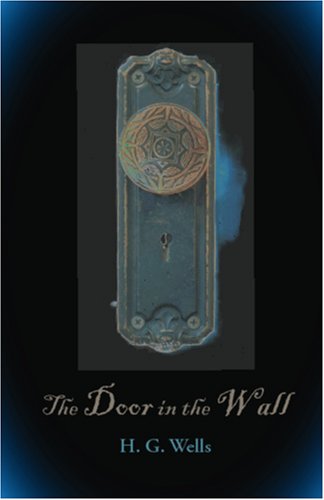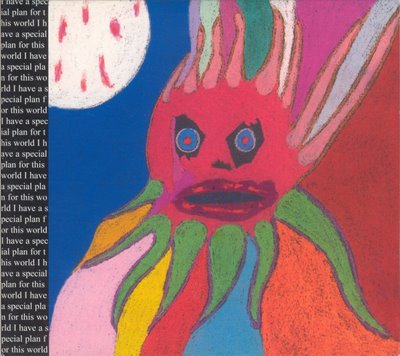Weird/ Psychoanalysis
Mon. December 17, 2007Categories: Abstract Dynamics
Heuristic England with a fascinating account of ‘Le Délire de Négation’, aka Cotard’s syndrome. (It sounds like Judge Schreber might have suffered from this condition, in which sufferers often believe that they have no stomach and bowels.)
The Heuristic England post takes up one of the most interesting discussions at the recent symposium on The Weird, on the relation of negativity, the horrible and horror to the Weird. My position remains that there is no necessary relation between the Weird and Horror, which is not, evidently, to say that the Weird cannot be horrible, only that it need not be. The Weirdness of ‘The Door in the Wall’ does not arise from the ‘horrible’ elements of the story – Wallace’s death and derangement – but from the ‘out of placeness’ of the garden in quotidian London, the incommensurability of the different worlds that Wallace travels between. I think it’s quite possible to imagine a different version of ‘The Door in the Wall’, one in which Wallace’s vision of the numinous was vindicated, without the tale losing its Weird charge.

- If you were to see written on a door panel: “This opens onto the void,” wouldn’t you still want to open it? – Baudrillard, Seduction
It strikes me that is it is not horror but fascination – albeit a fascination usually mixed with a certain trepidation, if not repulsion – that is integral to the Weird. I would argue, further, that if this element of fascination were entirely absent from a story, and if the story were merely horrible, it would no longer be Weird.
Fascination is the affect shared by Lovecraft’s characters and his readers. Fear or terror are not shared in the same way. Lovecraft’s characters are often terrified, but his readers seldom, if ever, are. It is fascination, above all else, that is the engine of fatality in Lovecraft’s fictions, fascination that draws his bookish characters towards the dissolution, disintegration or degeneration that we, the readers, always foresee. This is the death drive not in the sense of an impulse towards homeostasis – as China rightly pointed out, and as Graham Harman’s philosophy establishes, the Weird deprives us of the consoling idea of a final state of quiescence by showing that that there is no truly inanimate, that there is no end to the teeming (echoing Lacan, who according to Copjec, ‘pictures the real as teeming with emptiness, as a swarming void‘). The death drive in question is the drive which Zizek has so tirelessly described: an undeath drive that is not directed towards organic death but which persists in a state of zombie twitch immortality, indifferent to the end of the organism. That is why Ben is right to suggest that the rendezvous between Zizek and Lovecraft is a missed appointment. Yet for me this is not because Lovecraft is a pessimistic author, but because his writing fairly froths and foams with jouissance. ‘Frothing’, ‘foaming’, ‘teeming’, are themselves Lovecraftian words, of course, but they could apply equally well to the ‘obscene jelly’ of jouissance. This is not to make the absurd claim that there is no negativity in Lovecraft – the loathing and abomination are hardly concealed -, only that negativity does not have the last word. Lovecraft-the-symptom, in fact, is an exemplary demonstration of the advance that psychoanalysis makes over pessimsim. Freud remarks during Beyond the Pleasure Principle that ‘we have unwittingly steered our course in the harbour of Schopenhauer’s philosophy’. But what Freud establishes in Beyond the Pleasure Principle, surely, is that the enjoyment of what is supposedly negative, the taking of pleasure from what is ostensibly painful, wrecks any possibility of a total pessimism. An excessive preoccupation with objects that are ‘officially’ negative always indicates the work of jouissance – a mode of enjoyment which does not in any sense ‘redeem’ negativity: it sublimates it. That is to say, it transforms an ordinary object causing displeasure into a Thing which is both terrible and alluring, which can no longer be libidinally classified as either positive or negative. The Thing overwhelms, it cannot be contained, but it fascinates.
Ligotti’s unknown pleasures

It was in the session that the relation between the Weird and negativity came into sharpest focus. Ligotti’s texts are marked by a tension between his personal philosophy of total pessimism and his writing practice, which – perforce, performatively – contradicts the unremitting negativity of his official worldview. Since Ligotti recurrently suffers from anhedonia, the inability to take pleasure, in his texts, as James Burton astutely put it, it is pleasure that is the noumenal, the unknowable. But, rather like Beckett’s Unnamable – the Lovecraftian echo here hardly need be stressed at this point – Ligotti finds that the sheer fact of writing mitigates his pessimism. It would be a mistake to read The Unmamable’s ‘I’ll go on’ redemptively, as the triumph of some indomitable spirit, human or otherwise. Beckett makes contact instead with an intensive negativity, a purgatorial continuum in which things can always get worse, without ever reaching the relief of the worst. Total negativity would yield quiescence, yet for Beckett, as for Ligotti, silence and stasis are unattainable, they lie outside texts which might be for nothing but which are not, cannot be, nothing. Those afflicted with being might yearn for nothingness, yet even their dreams belong to being.
The ontological haemorrhage to which Beckett’s ‘characters’ in the Trilogy are subject – the collapsing of Molloy’s world into the worlds of Malone, Macmann and the Unnnamable – is echoed in Ligotti by the repeated ‘moment of consummate disaster, when the puppet turns to face the puppet master’. Just as ‘the Unnamable not only imagines characters, he also tries to imagine himself as the character of someone else‘ (McHale) so Ligotti’s marionettes begin to see ‘themselves’ as interiorless iterations in a purgatorial recursive structure which extends ‘upwards’ (towards an ostensible master who turns out to be a puppet) and ‘downwards’ (towards a puppet who leers at his supposed master) infinitely. This is a reverse Leibnizian hypercosmos, in which whatever world you are in, it is always the worst; where worlds, far from being incompossible, all end up bleeding into one another, as a kind of oozing ontological cancer consumes every possible world. Ligotti’s is a version of Plantinga’s transworld depravity, except the corruption belongs to Creation itself, and to any act of creation. To conjure something out of nothing is always unforgivable: because, once created, there is no way back out to non-being. This is a kind of Gnosticism without a demiurge, where every being is both a blind idiot god and a helpless puppet who only has the power to curse its creator. The horror of profound depression is not just the feelings of negativity, but the impossibility of living the negativity, the discrepancy between the dejection of one’s affective condition and what Francis Bacon called the optimism of your nervous system. Having lost the will to live, you find that life does not require will – or at least, it does not need your will. Even when you feel that you are a living corpse, the organs possess a will of their own.

At this point, we have passed beyond the Weird. As Ray argued, Ligotti tries to pursue the Weird-as-such, a Weird in itself, a Weird entirely estranged from naturalism and any recognizable world. Yet Ligotti’s stories in this mode become exercises in mannerism which lose the Weird. His Weirdest story – and his most successful in my view – is the eerie unmade screenplay Crampton in which all of Ligotti’s motifs are inserted into an American landscape of cheap TV adverts and greasy small town cafes.
Sublimation and Weird Psychoanalysis

English Heretic’s highly stimulating presentation gave me an answer to the question I had posed about psychoanalysis’s relationship to the Weird. What is reactionary about psychoanalysis is intricately tied up with what is most radical about it, which is why Anti-Oedipusand The Century can both be right when they, respectively, attack Freud for his familialism and celebrate psychoanalysis for its denaturalization of the family structure. English Heretic looked at the etymological roots of the word ‘weird’ in the concept of the Wyrd as weaver of Fate. It was Shakespeare who introduced ‘weird’ into the English language in the Fate-driven story of Macbeth; and, in its hyperstitional structure, Macbeth interestingly echoes the story of Oedipus. In both, the prophecies generate the catastrophe; or, rather, the attempt to escape the prophecies makes them come true. The signs are themselves the engine of fatality. (See here for my previous discussion of the Oedipus myth as a closed loop paradox: ‘one knows in advance one’s destiny, one tries to evade it, and it is by means of this very attempt that the predicted destiny realizes itself.’ [Sublime Object of Ideology .)
It is no accident – or rather, it is the kind of accident that it is necessary – that the Oedipus story should become so central to psychoanalysis, since it is precisely about the capturing of the Weird in a family drama. If Oedipus and Macbeth consitute a bad fatality, then English Heretic outlined the contours of an anti-Oedipal virtuous fatality, a kind of Dadaist sorcery which makes Fate out of a chance encounter. The aleatory systems of Dadaism provide the model for an account of sublimation which is not hampered – as Copjec argues that Freud’s was – ‘by the “epistemological obstacle” of [Freud’s] conservative taste in art’. (This by contrast with Lacan, of course, who ‘had a different understanding of art and a close association with the surrealist avant garde’.)
The central problem of Dada and Surrealism – the one that Duchamp kept returning to – was exactly the one that English Heretic laid out: the fatal twinning of chance and necessity. Its aleatory systems were not just machines that would produce random effects, but, far more importantly, systems that would transform a ‘chance encounter’ into a necessity. Dada and Surrealist practice can be seen precisely as a Weird psychoanalysis, which, instead of shooing away strange animals, or looking for the roots of aberrant machines in family relations, cultivated a positive psychopathology from bizarre juxtapositions in experience. Witness one of EH’s examples, Max Ernst:
- One of his best friends, a most intelligent and affectionate pink cockatoo, died in the night of January 5th. It was an awful shock to Max when he found the corpse in the morning and when, at the same moment, his father announced to him the birth of his sister Loni. The perturbation of the youth was so enormous that he fainted. In his imagination he connected both events and charged the baby with the extinction of the bird’s life. A series of mystical crises, fits of hysteria, exaltations and depressions followed. A dangerous confusion between birds and humans became encrusted in his mind and asserted itself in his drawings and paintings (1906-1914). Excursions in the world of marvels, chimeras, phantoms, powers, monsters, philosophers, birds, women, lunatics, magi, trees, eroticism, stones, insects, mountains, poisons, mathematics and so on.(1924). (from Nadia Choucha, Surrealism & The Occult)
Ben has described how the object of horror in Lovecraft is often this ‘surrealist avant garde’ itself. But, in making the avant garde so central – and what could be more central to Lovecraft than his official object of loathing? – Lovecraft’s ‘reactionary modernism’ was constitutively unable to abject the avant garde, and became instead fatally infected with it, implicated in it.
Lacan, on the other hand, is a kind of aggravated or ultra-modernist whose style and theory could be seen as the result of the subjecting one modernism – Freud’s psychoanalysis – to the techniques of another (Dada/ Surrealism). Ballard performs a similar operation; although he does so, not with the rarefied materials of high modernism, but as a pulp modernist who montages Dada into the media landscape; or, better, he sees the ways in which the media landscape was already Dadaist. And what is Deleuze-Guattari’s schizoanalysis if not a psychoanalysis given over to the Weird? A Thousand Plateaus, with its repeated references to Lovecraft, Moby Dick and The Incredible Shrinking Man, is in part a book of the American Weird. And Baudrillard, the great reader of Ballard and P K Dick, wasn’t he, too, fascinated by the Weird (as well as being one of the greatest theorists of the fatal pull of fascination)?
- That which looks onto nothing has every reason to be opened. … That which is arbitrary is simultaneously endowed with a total necessity. The predestination of the empty sign, the precession of the void, the vertigo of an obligation devoid of sense, a passion for necessity. – Baudrillard, Seduction
